| |
 |
 |
| |
| India
Coinage: 1987 - 1991 |
|
under President:
Ramaswamy Venkataraman |
| |
| Currency: |
| The Indian rupee (sign: ₹; code: INR) is the
official currency of the Republic of India. The rupee is subdivided into 100
paise (singular paisa), though as of 2018, coins of denomination of 100
paise or one rupee is the lowest value coin in use. The issuance of the
currency is controlled by the Reserve Bank of India. The Reserve Bank
manages currency in India and derives its role in currency management on the
basis of the Reserve Bank of India Act, 1934. The rupee is named after the
silver coin, rupiya, first issued by Sultan Sher Shah Suri in the 16th
century and later continued by the Mughal Empire. |
Mint Marks:
B - Mumbai (Bombay), proof issues only (1969 until 1995)
(B) - Mumbai (Bombay), diamond
C Ottawa (1985 25 Paise; 1988 10, 25 & 50 Paise)
(C) Kolkata (Calcutta) no mint mark
H - Birmingham (1985 Rupee only)
(H) - Hyderabad, star (1963)
(Hd) - Hyderabad, diamond split vertically (1953-1960)
(Hy) - Hyderabad, incuse dot in diamond (1960-1968)
(K) - Kremnica, Slovakia, MK in circle
(L) British Royal Mint, Llantrisant (1985 rupee only), diamond below first
date digit(Ld) British Royal Mint
Llantrisant, tower, looks like a bridge
M - Mumbai (Bombay), proof only starting 1996
(M) - Mexico City, M beneath O
(N) - Noida, dot
(P) - Pretoria, M in oval
(R) Moscow, MMD in oval
(T) - Taegu (Korea), star below first or last date (1997 and 1998 2 Rupees
only)From 1950 through 1964 the Republic of India proof coins carry the
regular diamond mint mark and can be distinguished from circulation issues
only by their proof-like finish. From 1969 proofs carry the capital B mint
mark. Some Bombay issues after 1969 have a proof-like appearance although
bearing the diamond mint mark of circulation issues. Beginning in 1972
proofs of the larger denominations - 10, 20 and 100 rupees -were partly
frosted on their main features, including numerals. From 1975 all proofs
were similarly frosted, from the 1 paisa to 100 rupees. Proof-like issues
are often erroneously offered as proofs. |
| |
| |
| 1987 |
| |
|
|
|
|
 |
KM#44 20 paise.
Year: 1987.
Weight: 2.30 g
[2.20g].
Metal:
Aluminium.
Diameter: 24.50 mm
x 26.00 mm; Hexagonal (6-sided).
Thickness:
1.70 mm. Edge:
Plain. Alignment:
Medal. Mint:
Calcutta (No mintmark below Date). |
|
Obverse:
"पैसे" (paise) written in Devnagari at
the top section. Numerals "20" written in the center with "PAISE"
written below it. Date and mintmark at the bottom. All details surrounded by
circular design at the border.
Reverse:
Ashoka Pillar Lion Capitol in the center with
"सत्यमेव
जयते" (Satyameva Jayate) [Truth alone triumphs
/ Truth shall prevail] written below
it. "भारत"
(bharat) written on the left side clockwise and "INDIA" written on
the right side clockwise.
Mintage:
N/A. Mintage Years:
1982 (B), 1982 (H), 1982 (H) without
mintmark, 1983 (C), 1983 (H), 1984 (B), 1984 (C), 1984 (H), 1985
(B), 1985 (C), 1985 (H), 1986 (B), 1986 (C), 1986 (H), 1987 (C),
1987 (H), 1988 (B), 1988 (C), 1988 (H), 1989 (C), 1989 (H), 1990
(C), 1990 (H), 1991 (C), 1991 (H), 1992 (H), 1994 (H), 1996 (H) and
1997 (H).
Demonetized: 30
June 2011. |
|
 |
Same as above KM#44
20 paise,
but...
Year: 1987.
Weight: 2.19 g
[2.20g].
Mint:
Hyderabad (Star mintmark below Date). Mintage:
153,073,000. |
|
 |
 |
|
KM#49.1 25 paise.
Year: 1987.
Weight: 2.50 g
[2.50g].
Metal:
Copper-Nickel.
Diameter: 19.00 mm.
Thickness:
1.36 mm. Edge:
Reeded. Alignment:
Medal. Mint:
Hyderabad (Star mintmark below Date).
Type 49.1:
Each type has unique redesigned of Ashoka Pillar Lion
Capitol. 9.0 mm between lions' nose tips. Bull has three legs. Side
lions toothless with 2 to 3 fur rows, short squat D (Fat and
downwards) in INDIA.
Obverse:
"पैसे" (paise) written in Devnagari
at the top left side. "PAISE" written at the top right side. Numerals "25" written in the center with Date and mintmark
below it. Knot wreath at the bottom section. Decorative-toothed rim.
Reverse:
Ashoka Pillar Lion Capitol in the center. "भारत"
(bharat) written on the left side clockwise and "INDIA" written on
the right side clockwise. Decorative-toothed rim.
Mintage:
341,160,000 (including Calcutta and Hyderabad
mints). Mintage Years:
1972 (B), 1972 B (Proof), 1972 (H),
1973 (B), 1973 B (Proof), 1973 (H), 1974 (B), 1974 B (Proof), 1974
(H), 1975 (B), 1975 B (Proof), 1975 (H), 1976 (B), 1976 B (Proof),
1976 (H), 1977 (B), 1977 (C), 1977 (H), 1978 B (Proof), 1978 (C),
1978 (H), 1979 (C), 1979 (H), 1980 (C), 1980 (H), 1981 (B), 1981
(C), 1981 (H), 1982 (B), 1982 (C), 1983 (C), 1984 (B), 1984 (C),
1984 (H), 1985 (B), 1985 (C), 1985 (H), 1985C (Ottawa, Canada), 1986
(B), 1986 (C), 1986 (H), 1987 (B), 1987 (C), 1987 (H), 1988 1.8mm
"88" in date (C), 1988 (H) and 1989 (H).
Demonetized: 30
June 2011. |
|
 |
 |
|
KM#49.5 25 paise.
Year: 1987.
Weight: 2.46 g
[2.50g].
Metal:
Copper-Nickel.
Diameter: 19.00 mm.
Thickness:
1.36 mm. Edge:
Reeded. Alignment:
Medal. Mint:
Bombay (Diamond mintmark below Date).
Type 49.5:
Each type has unique redesigned of Ashoka Pillar Lion
Capitol. 9.0 mm between lions' nose tips. 2 teeth on each side lion,
4 to 5 clear line fur rows, smaller lion head. Bull has three legs.
Short squat D (Fat and downwards) in INDIA.
Obverse:
"पैसे" (paise) written in Devnagari
at the top left side. "PAISE" written at the top right side. Numerals "25" written in the center with Date and mintmark
below it. Knot wreath at the bottom section. Decorative-toothed rim.
Reverse:
Ashoka Pillar Lion Capitol in the center. "भारत"
(bharat) written on the left side clockwise and "INDIA" written on
the right side clockwise. Decorative-toothed rim.
Mintage:
N/A. Mintage Years:
1986 (B), 1986 (C), 1986 (H), 1987 (B), 1987
(C), 1987 long "7" in Date (C), 1988 (B), 1988 1.3mm "88" in date
(C), 1988 1.8mm "88" in date (C), 1988 (H), 1989 (B), 1989 (C), 1990
(B) and 1990 (C).
Demonetized: 30
June 2011. |
|
 |
Same as above KM#49.5
25 paise,
but...
Year: 1987 Long 7.
Weight: 2.51 g
[2.50g].
Mint: Calcutta (No mintmark below Date).
Mintage:
N/A.
Type5:
9.0 mm between lions' nose tips. 2 teeth on each side lion, 4 to 5 clear
line fur rows, smaller lion head. Bull has three legs. Short squat D
(Fat and downwards) in INDIA. |
|
 |
KM#65 50 paise.
Year: 1987.
Weight: 5.01 g
[5.00g].
Metal:
Copper-Nickel.
Diameter: 23.50 mm.
Thickness:
1.50 mm. Edge:
Reeded. Alignment:
Medal. Mint:
Bombay (Diamond mintmark below Date). |
|
Obverse:
Numerals "50" written in the center. "पैसे" (paise) written in Devnagari at
left side clockwise and "PAISE" at the right side clockwise of
Numerals "50".
Date with mintmark below Numerals "50". 12 same designs in circular
form near border.
Reverse:
Ashoka Pillar Lion Capitol in the center. "भारत"
(bharat) written on the left side clockwise and "INDIA" written on
the right side clockwise of Ashoka Pillar. 12 same designs in
circular form near border.
Mintage:
145,140,000. Mintage Years:
1984 (B), 1984 (C), 1984 (Hy), 1985 (B), 1985
(C), 1985 (Hy), 1985 (T), 1986 (C), 1987 (B), 1987 (C), 1987 (Hy),
1988 (B), 1988 (C), 1988 (Hy), 1989 (B), 1989 (C), 1989 (Hy) and
1990 (B). |
|
 |
Same as above coin KM#65, 50 paise, but...
Year: 1987.
Weight: 4.97 g
[5.00g].
Mint:
Calcutta (No mintmark below Date). Mintage:
N/A. |
|
 |
Same as above coin KM#65, 50 paise, but...
Year: 1987.
Weight: 4.96 g
[5.00g].
Mint:
Hyderabad (Star mintmark below Date). Mintage:
N/A. |
|
 |
KM#79.1 Rupee.
Year: 1987.
Weight: 6.13 g
[6.00g].
Metal: Copper-Nickel.
Diameter: 26.00 mm.
Thickness:
1.47 mm. Edge:
Security. Alignment:
Medal. Mint:
Bombay (Diamond mintmark below Date). Obverse:
"रुपया"
(rupaya) written at the top. Numeral "1" in the center with grain ears
flank on each side. "RUPEE" written below numeral "1". Date written
at the bottom. Dots in heptagonal form near the border. Obverse Type1:
The Horse and Cow details in Pedestal of Ashoka Pillar Lion Capitol
are less visible. |
|
Reverse:
Ashoka Pillar Lion Capitol in the center with
"सत्यमेव
जयते" (Satyameva Jayate) [Truth alone triumphs]
written below it. "भारत"
(bharat) written on the left side clockwise and "INDIA" written on
the right side clockwise. Dots in heptagonal form near the border.
Mintage:
685,502,000.
Mintage Years:
1982 (B), 1983 (B), 1983 (C), 1984 (B), 1984
(C), 1984 (Hy), 1985 (B), 1985 (C), 1985 H (Heaton, UK), 1985 (L =
Llantrisant, UK), 1986 (B), 1986 (C), 1986 (Hy), 1987 (B), 1987 (C),
1987 (Hy), 1988 (B), 1988 (C), 1988 (Hy), 1988 (N), 1989 (B), 1989
(C), 1989 (Hy), 1989 (N), 1990 (C) and 1990 (Hy). |
|
 |
Same as above KM#79.1 Rupee,
but...
Year: 1987.
Weight: 6.00 g
[6.00g]. Mint:
Hyderabad (Star mintmark below Date). Mintage:
N/A (included in Bombay mint). |
|
 |
KM#81 Rupee.
Year: 1987.
Weight: 6.01 g
[6.00g].
Metal: Copper-Nickel.
Diameter: 25.50 mm.
Thickness:
1.47 mm. Edge:
Security. Alignment:
Medal. Mint:
Bombay (Diamond mintmark below Date). |
|
Obverse: FAO logo
at the top. A man and a woman farmer are bending to check their
crops in water. "छोटे किसान" (chhote kisaan) [Small farmers] written
in Hindi at the left side. "SMALL FARMERS" written at the right
side. Date "1987" and mintmark written in water, below the
farmers. Heptagonal form near the border.
Reverse:
Ashoka Pillar Lion Capitol in the top center
position with "सत्यमेव
जयते" (Satyameva Jayate) [Truth alone triumphs]
written below it. "भारत"
(bharat) written on the top left side clockwise and "INDIA" written
on the top right side clockwise. "रुपया"
(rupaya) written at the bottom left side anti-clockwise and "RUPEE"
written at the bottom right side anti-clockwise. Numeral "1"
written at the bottom. Heptagonal form near the border. Mintage:
234,223,000.
Mintage Years:
1987 (B), 1987 (Proof with "B" mintmark), 1985 (C) and 1985 (Hy).
Subject:
FAO - Small Farmers. |
|
 |
Same as above KM#81 Rupee,
but...
Year: 1987.
Weight: 6.00 g
[6.00g]. Mint:
Hyderabad (Star mintmark below Date). Mintage:
191,120,000. |
| |
|
|
| |
| 1988 |
| |
| |
|
|
 |
Same as above KM#44
20 paise,
but...
Year: 1988.
Weight: 2.23 g
[2.20g].
Mint:
Bombay (Diamond mintmark below Date). Mintage:
125,048,000 (including all three mints). |
|
 |
Same as above KM#44
20 paise,
but...
Year: 1988.
Weight: 2.22 g
[2.20g].
Mint:
Calcutta (No mintmark below Date). Mintage:
N/A (including above). |
|
 |
Same as above KM#49.1
25 paise,
but...
Year: 1988.
Weight: 2.45 g
[2.50g].
Mint: Hyderabad (Star mintmark below Date).
Mintage:
303,252,000.
Type1:
9.0 mm between lions' nose tips. Bull has three legs. Side lions
toothless with 2 to 3 fur rows, short squat D in INDIA. |
|
 |
Same as above KM#49.5
25 paise,
but...
Year: 1988.
Weight: 2.58 g
[2.50g].
Mint: Bombay (Diamond mintmark below Date).
Mintage:
N/A.
Type5:
9.0 mm between lions' nose tips. 2 teeth on each side lion, 4 to 5 clear
line fur rows, smaller lion head. Bull has three legs. Short squat D
(Fat and downwards) in INDIA. |
|
 |
Same as above KM#49.5
25 paise,
but...
Year: 1987 Large 88.
Weight: 2.49 g
[2.50g].
Mint: Calcutta (No mintmark below Date).
Mintage:
N/A.
Type5:
9.0 mm between lions' nose tips. 2 teeth on each side lion, 4 to 5 clear
line fur rows, smaller lion head. Bull has three legs. Short squat D
(Fat and downwards) in INDIA. |
|
 |
KM#54 25 paise.
Year: 1988.
Weight: 2.82 g
[2.83g].
Metal:
Stainless Steel.
Diameter: 19.00 mm.
Thickness:
1.55 mm. Edge:
Plain. Alignment:
Medal. Mint:
Bombay (Diamond mintmark below Date). |
|
Obverse:
Date with mintmark below it, at the top. Indian Rhinoceros standing
on grass while facing left, in the center.
Reverse: Small Ashoka Pillar Lion Capitol
at the top with
"सत्यमेव
जयते" (Satyameva Jayate) [Truth alone
triumphs] written below it. "भारत"
(bharat) written on the top left side clockwise. "INDIA" written on
the top right side clockwise. "पैसे" (paise)
written at the bottom left side anti-clockwise. "PAISE" written at
the bottom right side anti-clockwise. Large Numerals "25"
written at the bottom section. Mintage:
N/A.
Mintage Years:
1988 (B), 1988 (C), 1988C (Ottawa, Canada),
1988 (H), 1988 (N), 1989 (C) fine grass below rhino, 1989 (C) bold
grass below rhino, 1989 (H), 1989 (N), 1990 (B), 1990 (C), 1990 (H),
1990 (N) Small mintmark, 1991 (B), 1991 (C), 1991 (H), 1991 (N),
1992 (B), 1992 (C), 1992 (H), 1992 (N), 1993 (B), 1993 (C), 1993
(H), 1993 (N), 1994 (B), 1994 (C), 1994 (H), 1994 (N), 1995 (B),
1995 (C), 1995 (H), 1995 (N), 1996 (B), 1996 (C), 1996 (H), 1996
(N), 1997 (B), 1997 (C), 1997 (H), 1997 (N), 1998 (B), 1998 (C),
1998 (H), 1998 (N), 1999 (B), 1999 (C), 1999 (H), 1999 (N), 2000
(B), 2000 (C), 2000 (H), 2000 (N), 2001 (B), 2001 (C), 2001 (H),
2002 (B), 2002 (C) and 2002 (H).
Demonetized:
30th June 2011. |
|
 |
Same as above KM#54
25 paise,
but...
Year: 1988.
Weight: 2.83 g
[2.83g].
Mint:
Calcutta (No mintmark below Date). Mintage:
18,920,000. |
|
 |
Same as above KM#54
25 paise,
but...
Year: 1988.
Weight: 2.82 g
[2.83g].
Mint:
Hyderabad (Star mintmark below Date). Mintage:
N/A. |
|
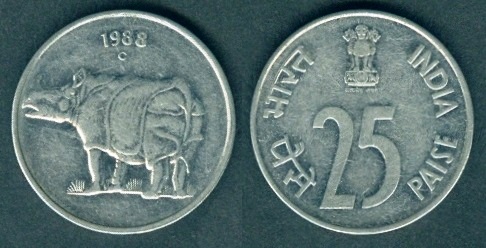 |
Same as above KM#54
25 paise,
but...
Year: 1988.
Weight: 2.85 g
[2.83g].
Mint:
Ottawa, Canada ("C" mintmark below Date).
Mintage:
305,280,000. |
|
 |
Same as above coin KM#65, 50 paise, but...
Year: 1988.
Weight: 4.83 g
[5.00g].
Mint:
Bombay (Diamond mintmark below Date). Mintage:
149,092,000. |
|
 |
Same as above coin KM#65, 50 paise, but...
Year: 1988.
Weight: 5.10 g
[5.00g].
Mint:
Calcutta (No mintmark below Date). Mintage:
N/A. |
|
 |
Same as above coin KM#65, 50 paise, but...
Year: 1988.
Weight: 4.98 g
[5.00g].
Mint:
Hyderabad (Star mintmark below digit "8" in Date). Mintage:
N/A. |
|
 |
KM#69 50 paise.
Year: 1988.
Weight: 3.73 g
[3.80g].
Metal:
Stainless Steel.
Diameter: 22.00 mm.
Thickness:
1.45 mm. Edge:
Plain. Alignment:
Medal. Mint:
Bombay (Diamond mintmark below Date). Obverse:
Map of India imposed by circular Parliament house building in New
Delhi in the center. "भारत"
(bharat) written on the top right side clockwise followed by the
word "INDIA" also clockwise. Date with mintmark at the bottom. |
|
Reverse: Small Ashoka Pillar Lion Capitol
at the top with
"सत्यमेव
जयते" (Satyameva Jayate) [Truth alone triumphs]
written below it. Large Numerals "50" written below Ashoka Pillar
Lion Capitol. "भारत"
(bharat) written on the top left side clockwise. "INDIA" written on
the top right side clockwise. "पैसे" (paise)
written at the bottom left side anti-clockwise. "PAISE" written at
the bottom right side anti-clockwise. Mintage:
N/A.
Mintage Years:
1988 (B), 1988 (C), 1988 (Hy), 1988 (N), 1988
(C below date = Ottawa, Canada), 1989 (B), 1989 (C), 1989 (Hy), 1989
(N), 1990 (B), 1990 (C), 1990 (Hy), 1990 (N with small dot), 1990 (N
with large dot), 1991 (B), 1991 (C), 1991 (Hy), 1991 (N), 1992 (B),
1992 (C), 1992 (Hy), 1992 (N), 1993 (C), 1993 (N), 1994 (B), 1994
(C), 1994 (Hy), 1994 (N), 1995 (B), 1995 (C), 1995 (Hy), 1995 (N),
1996 (B), 1996 (C), 1996 (Hy), 1996 (N), 1997 (B), 1997 (C), 1997 (Hy),
1997 (N), 1998 (B), 1998 (C), 1998 (Hy), 1998 (N), 1999 (B), 1999
(C), 1999 (Hy), 1999 (N), 2000 (B), 2000 (C), 2000 (Hy), 2000 (N),
2001 (B), 2001 (C), 2001 (Hy), 2001 (N), 2002 (B), 2002 (C), 2002 (Hy),
2002 (N), 2003 (B), 2003 (C), 2003 (N), 2007 (C) and 2007 (N).
Demonetized:
30th June 2011. |
|
 |
Same as above KM#69 50 paise,
but...
Year: 1988.
Weight: 3.74 g
[3.80g]. Mint:
Noida (Dot mintmark below Date). Mintage:
N/A. |
|
 |
Same as above KM#69 50 paise,
but...
Year: 1988.
Weight: 3.73 g
[3.80g]. Mint:
Ottawa, Canada (C mintmark below Date). Mintage:
272,160,000. |
|
 |
Same as above KM#79.1 Rupee,
but...
Year: 1988.
Weight: 6.04 g
[6.00g]. Mint:
Bombay (Diamond mintmark below Date). Mintage:
240,447,000. |
|
 |
KM#79.2 Rupee.
Year: 1988.
Weight: 6.08 g
[6.00g].
Metal: Copper-Nickel.
Diameter: 26.00 mm.
Thickness:
1.47 mm. Edge:
Security. Alignment:
Medal. Mint:
Bombay (Diamond mintmark below Date). Obverse:
"रुपया"
(rupaya) written at the top. Numeral "1" in the center with grain ears
flank on each side. "RUPEE" written below numeral "1". Date written
at the bottom. Dots in heptagonal form near the border. Obverse Type2:
The Horse and Cow details in Pedestal of Ashoka Pillar Lion Capitol
are more visible. |
|
Reverse:
Ashoka Pillar Lion Capitol in the center with
"सत्यमेव
जयते" (Satyameva Jayate) [Truth alone triumphs]
written below it. "भारत"
(bharat) written on the left side clockwise and "INDIA" written on
the right side clockwise. Dots in heptagonal form near the border. Mintage:
685,502,000.
Mintage Years:
1988 (B), 1989 (N) and 1990 (N). |
|
 |
KM#79.3 Rupee.
Year: 1988.
Weight: 5.88 g
[6.00g].
Metal: Copper-Nickel.
Diameter: 26.00 mm.
Thickness:
1.47 mm. Edge:
Security. Alignment:
Medal. Mint:
Bombay (Diamond mintmark below Date). Obverse:
Ashoka Pillar Lion Capitol in the center with
"सत्यमेव
जयते" (Satyameva Jayate) [Truth alone triumphs]
written below it. "भारत"
(bharat) written on the left side clockwise and "INDIA" written on
the right side clockwise. Dots in heptagonal form near the border. Obverse Type3:
Lions' chest hairs restyled. |
|
Reverse:
"रुपया"
(rupaya) written at the top. Numeral "1" in the center with grain ears
flank on each side. "RUPEE" written below numeral "1". Date written
at the bottom. Dots in heptagonal form near the border. Mintage:
N/A.
Mintage Years:
1988 (B), 1989 (B) and 1990 (B). |
|
 |
Same as above KM#79.1 Rupee,
but...
Year: 1988.
Weight: 5.78 g
[6.00g]. Mint:
Calcutta (No mintmark below Date). Mintage:
N/A (included in Bombay mint). |
|
 |
KM#82 Rupee.
Year: 1988.
Weight: 5.94 g
[6.00g].
Metal: Copper-Nickel.
Diameter: 25.50 mm.
Thickness:
1.47 mm. Edge:
Security. Alignment:
Medal. Mint:
Bombay (Diamond mintmark below Date). |
|
Obverse: Date
"1988" and mintmark written at the top. A woman farmer holding two
large sunflowers in the sunflower field, cow on the left side in the
background, cloud showering rain the top right side near the
mountains. "वर्षा सिंचित खेती" (varsha sinchit khetee) [Rain
fed farming] written
in Hindi at the top left side. "RAIN FED FARMING" written at the
top right
side. "FAO" written at the bottom right side. Heptagonal
form near the border.
Reverse:
Ashoka Pillar Lion Capitol in the top center
position with "सत्यमेव
जयते" (Satyameva Jayate) [Truth alone triumphs]
written below it. "भारत"
(bharat) written on the top left side clockwise and "INDIA" written
on the top right side clockwise. "रुपया"
(rupaya) written at the bottom left side anti-clockwise and "RUPEE"
written at the bottom right side anti-clockwise. Numeral "1"
written at the bottom. Heptagonal form near the border. Mintage:
N/A.
Mintage Years:
1985 (B), 1985 (C) and 1985 (Hy).
Subject:
FAO - Rain Fed Farming. |
| |
|
|
| |
| 1989 |
| |
| |
|
|
 |
Same as above KM#44
20 paise,
but...
Year: 1989.
Weight: 2.20 g
[2.20g].
Mint:
Calcutta (No mintmark below Date). Mintage:
N/A. |
|
 |
Same as above KM#44
20 paise,
but...
Year: 1989.
Weight: 2.31 g
[2.20g].
Mint:
Hyderabad (Star mintmark below Date). Mintage:
N/A. |
|
 |
Same as above KM#49.1
25 paise,
but...
Year: 1989.
Weight: 2.39 g
[2.50g].
Mint: Bombay (Diamond mintmark below Date).
Mintage:
N/A.
Type1:
9.0 mm between lions' nose tips. Bull has three legs. Side lions
toothless with 2 to 3 fur rows, short squat D in INDIA. |
|
 |
Same as above KM#49.5
25 paise,
but...
Year: 1989.
Weight: 2.46 g
[2.50g].
Mint: Bombay (Diamond mintmark below Date).
Mintage:
N/A.
Type5:
9.0 mm between lions' nose tips. 2 teeth on each side lion, 4 to 5 clear
line fur rows, smaller lion head. Bull has three legs. Short squat D
(Fat and downwards) in INDIA. |
|
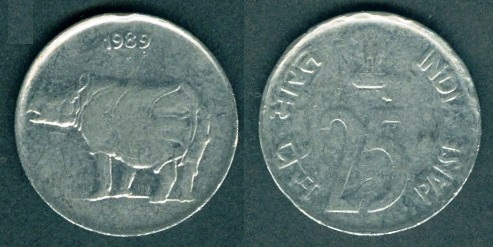 |
Same as above KM#54
25 paise,
but...
Year: 1989.
Weight: 2.81 g
[2.83g].
Mint:
Bombay (Diamond mintmark below Date). Mintage:
N/A. |
|
 |
Same as above KM#54
25 paise,
but...
Year: 1989.
Weight: 2.89 g
[2.83g].
Mint:
Calcutta (No mintmark below Date). Mintage:
N/A. |
|
 |
Same as above KM#54
25 paise,
but...
Year: 1989.
Weight: 2.83 g
[2.83g].
Mint:
Hyderabad (Star mintmark below Date). Mintage:
N/A. |
|
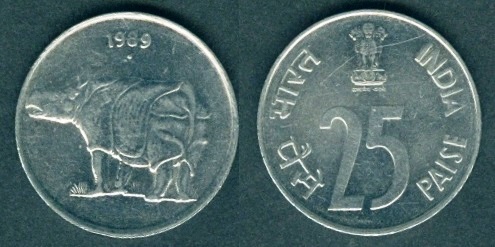 |
Same as above KM#54
25 paise,
but...
Year: 1989.
Weight: 2.83 g
[2.83g].
Mint:
Noida (Dot mintmark below Date). Mintage:
N/A. |
|
 |
Same as above coin KM#65, 50 paise, but...
Year: 1989.
Weight: 4.89 g
[5.00g].
Mint:
Bombay (Diamond mintmark below Date). Mintage:
N/A.
My coin is bended. |
|
 |
Same as above KM#69 50 paise,
but...
Year: 1989.
Weight: 3.77 g
[3.80g]. Mint:
Calcutta (No mintmark below Date). Mintage:
N/A. |
|
 |
Same as above KM#69 50 paise,
but...
Year: 1989.
Weight: 3.74 g
[3.80g]. Mint:
Hyderabad (Star mintmark below Date). Mintage:
N/A. |
|
 |
Same as above KM#69 50 paise,
but...
Year: 1989.
Weight: 3.81 g
[3.80g]. Mint:
Noida (Dot mintmark below Date). Mintage:
N/A. |
|
 |
Same as above KM#79.1 Rupee,
but...
Year: 1989.
Weight: 6.02 g
[6.00g]. Mint:
Bombay (Diamond mintmark below Date). Mintage:
N/A. |
|
 |
Same as above KM#79.3 Rupee,
but...
Year: 1989.
Weight: 6.02 g
[6.00g]. Mint:
Bombay (Diamond mintmark below Date). Mintage:
N/A.
Obverse Type3: Lions' chest hairs
restyled. |
|
 |
Same as above KM#79.1 Rupee,
but...
Year: 1989.
Weight: 6.00 g
[6.00g]. Mint:
Calcutta (No mintmark below Date). Mintage:
N/A. |
|
 |
Same as above KM#79.1 Rupee,
but...
Year: 1989.
Weight: 6.14 g
[6.00g]. Mint:
Hyderabad (Star mintmark below Date). Mintage:
N/A. |
|
 |
KM#83.1 Rupee.
Year: 1989.
Weight: 5.92 g
[6.00g].
Metal: Copper-Nickel.
Diameter: 25.50 mm.
Thickness:
1.47 mm. Edge:
Security. Alignment:
Medal. Mint:
Bombay (Diamond mintmark below Date).
Type1:
Short Denticles (Teeth) near rim on Obverse side. |
|
Obverse:
Jawaharlal Nehru portrait facing right in the center. "जवाहरलाल
नेहरु"
(Jawaharlal Nehru) written on the top left side clockwise.
"JAWAHARLAL NEHRU" written on the top right side clockwise. "जन्मशती"
(janmashatee) [Birth Centenary] written at the bottom left side anti-clockwise.
"CENTENARY" written at the bottom right side anti-clockwise. Date
"1989" written at the bottom with mintmark below it. Tooth border near the edge.
Reverse:
Ashoka Pillar Lion Capitol in the center
position with
"सत्यमेव
जयते" (Satyameva Jayate) [Truth alone triumphs]
written below it. "भारत"
(bharat) written on the top left side clockwise and "INDIA" written
on the top right side clockwise. "रुपया"
(rupaya) written at the bottom left side anti-clockwise and "RUPEE"
written at the bottom right side anti-clockwise. Numeral "1"
written at the bottom. Tooth border near the edge. Mintage:
N/A.
Mintage Years:
1989B,
1989 Bombay Proof, 1989 Bombay mint set, 1989C and 1989Hy.
Subject: 100th
Birth Anniversary of Jawaharlal Nehru (1889-1989).
Note: KM#83.2 Rupee has long
Denticles (Teeth) near rim on Obverse side, only produced by Bombay
mint.
Pandit Jawaharlal Nehru (14 November 1889 27 May 1964)
was an Indian independence activist, and subsequently, the first
Prime Minister (15 August 1947 27 May 1964) of India and a central
figure in Indian politics before and after independence. He emerged
as an eminent leader of the Indian independence movement and served
India as Prime Minister from its establishment as an independent
nation in 1947 until his death in 1964. He has been described by the
Amar Chitra Katha as the architect of India. He was also known as
Pandit Nehru due to his roots with the Kashmiri Pandit community
while Indian children knew him as Chacha Nehru (Hindi, lit., "Uncle
Nehru"). He was the son of Motilal Nehru, a prominent lawyer and
nationalist statesman and Swaroop Rani. Jawaharlal Nehru was a
graduate of Trinity College, Cambridge and the Inner Temple, where
he trained to be a barrister. Upon his return to India, he enrolled
at the Allahabad High Court and took an interest in national
politics, which eventually replaced his legal practice. A committed
nationalist since his teenage years, he became a rising figure in
Indian politics during the upheavals of the 1910s. He became the
prominent leader of the left-wing factions of the Indian National
Congress during the 1920s, and eventually of the entire Congress,
with the tacit approval of his mentor, Gandhi. As Congress President
in 1929, Nehru called for complete independence from the British Raj
and instigated the Congress's decisive shift towards the left. He
served as Minister of Defence: 10 February 1953 - 10 January 1955,
30 January 1957 - 17 April 1957 and 31 October 1962 - 14 November
1962. He served as Minister of Finance: 24 July 1956 - 30 August
1956 and 13 February 1958 - 13 March 1958. He served as Minister of
External Affairs: 02 September 1946 - 27 May 1964. He served as Vice
President of Executive Council: 02 September 1946 - 15 August 1947.
He was Member of Parliament, Lok Sabha: 1952-1964.
Nehru's health began declining steadily after 1962, and he spent
months recuperating in Kashmir through 1963. Some historians
attribute this dramatic decline to his surprise and chagrin over the
Sino-Indian War, which he perceived as a betrayal of trust. Upon his
return from Dehradun on 26 May 1964, Nehru was feeling quite
comfortable and went to bed at about 23:30 as usual, he had a
restful night until about 06:30 soon after he returned from
bathroom, Nehru complained of pain in the back. He spoke to the
doctors who attended on him for a brief while and almost immediately
Nehru collapsed. He remained unconscious until he died. His death
was announced to Lok Sabha at 14:00 local time on 27 May 1964 (same
day); cause of death is believed to be heart attack. |
|
 |
Same as above KM#83.1 Rupee,
but...
Year: 1989.
Weight: 6.03 g
[6.00g]. Mint:
Hyderabad (Star mintmark below Date). Mintage:
N/A. |
|
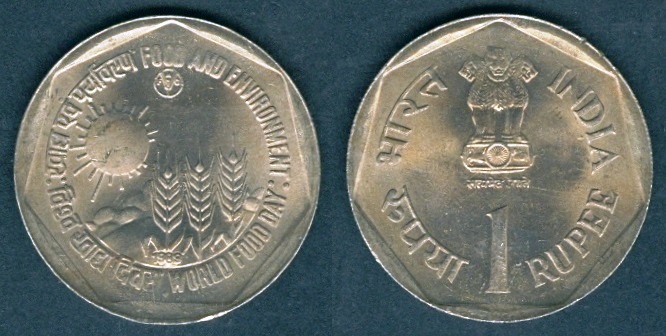 |
KM#84 Rupee.
Year: 1989.
Weight: 6.10 g
[6.00g].
Metal: Copper-Nickel.
Diameter: 25.50 mm.
Thickness:
1.47 mm. Edge:
Security. Alignment:
Medal. Mint:
Bombay (Diamond mintmark at the bottom on
Obverse side). |
|
Obverse:
Sun shinning on three wheat crops with FAO
logo above in the center. "खाद्य एवं पर्यावरण" (khaady evan
paryaavaran) [Food and Environment] written in Hindi at the top left side
clockwise. "RAIN FED FARMING" written at the
top right
side clockwise. "विश्व खाद्य दिवस" (vishv khaady divas) [World
Food Day] written in Hindi at the bottom left side anti-clockwise. "WORLD
FOOD DAY" written at the bottom right
side anti-clockwise. Date "1989" below the left wheat crop. Mintmark at the bottom. Heptagonal
form near the border.
Reverse:
Ashoka Pillar Lion Capitol in the top center
position with
"सत्यमेव
जयते" (Satyameva Jayate) [Truth alone triumphs]
written below it. "भारत"
(bharat) written on the top left side clockwise and "INDIA" written
on the top right side clockwise. "रुपया"
(rupaya) written at the bottom left side anti-clockwise and "RUPEE"
written at the bottom right side anti-clockwise. Numeral "1"
written at the bottom. Heptagonal form near the border. Mintage:
N/A.
Mintage Years:
1989B, 1989Hy and 1989N.
Subject: FAO -
World Food Day + Food and Environment. |
|
 |
| KM#151 5 Rupees.
Year: 1989.
Weight: 12.53 g
[12.50g].
Metal: Copper-Nickel.
Diameter: 30.50 mm.
Thickness:
2.30 mm. Edge:
Security. Alignment:
Medal. Mint:
Bombay (Diamond mintmark below Date).
Type:
Short Rim Teeth on the Obverse side.
Obverse:
Jawaharlal Nehru portrait facing right in the center. "जवाहरलाल
नेहरु"
(Jawaharlal Nehru) written on the top left side clockwise.
"JAWAHARLAL NEHRU" written on the top right side clockwise. "जन्मशती"
(janmashatee) [Birth Centenary] written at the bottom left side anti-clockwise.
"CENTENARY" written at the bottom right side anti-clockwise. Date
"1989" written at the bottom with mintmark below it. Tooth border near the edge.
Reverse:
Ashoka Pillar Lion Capitol in the center
position with
"सत्यमेव
जयते" (Satyameva Jayate) [Truth alone triumphs]
written below it. "भारत"
(bharat) written on the top left side clockwise and "INDIA" written
on the top right side clockwise. "रुपया"
(roopaye) written at the bottom left side anti-clockwise and "RUPEES"
written at the bottom right side anti-clockwise. Numeral "5"
written at the bottom. Tooth border near the edge. Mintage:
N/A.
Mintage Years:
1989B short rim teeth, 1989B long rim teeth,
1989 Bombay Proof, 1989 Bombay mint set, 1989Hy.
Subject: 100th
Birth Anniversary of Jawaharlal Nehru (1889-1989).
|
| |
|
|
| |
| 1990 |
| |
|
|
|
|
 |
Same as above KM#49.5
25 paise,
but...
Year: 1988.
Weight: 2.44 g
[2.50g].
Mint: Bombay (Diamond mintmark below Date).
Mintage:
N/A.
Type5:
9.0 mm between lions' nose tips. 2 teeth on each side lion, 4 to 5 clear
line fur rows, smaller lion head. Bull has three legs. Short squat D
(Fat and downwards) in INDIA. |
|
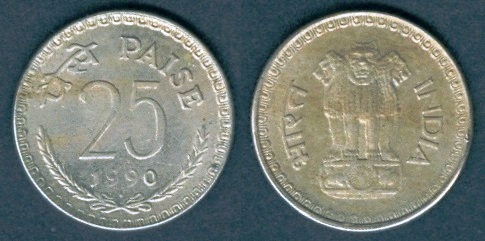 |
Same as above coin, but having Thick date.
Weight: 2.55 g
[2.50g]. |
|
 |
Same as above KM#54
25 paise,
but...
Year: 1990.
Weight: 2.79 g
[2.83g].
Mint:
Bombay (Diamond mintmark below Date). Mintage:
N/A. |
|
 |
Same as above KM#54
25 paise,
but...
Year: 1990.
Weight: 2.83 g
[2.83g].
Mint:
Calcutta (No mintmark below Date). Mintage:
N/A. |
|
 |
Same as above KM#54
25 paise,
but...
Year: 1990.
Weight: 2.84 g
[2.83g].
Mint:
Hyderabad (Star mintmark below Date). Mintage:
N/A. |
|
 |
Same as above KM#54
25 paise,
but...
Year: 1990.
Weight: 2.84 g
[2.83g].
Mint:
Noida (Dot mintmark below Date). Mintage:
N/A. |
|
 |
Same as above KM#44
20 paise,
but...
Year: 1990.
Weight: 2.22 g
[2.20g].
Mint:
Calcutta (No mintmark below Date). Mintage:
N/A. |
|
 |
Same as above KM#44
20 paise,
but...
Year: 1990.
Weight: 2.24 g
[2.20g].
Mint:
Hyderabad (Star mintmark below Date). Mintage:
N/A. |
|
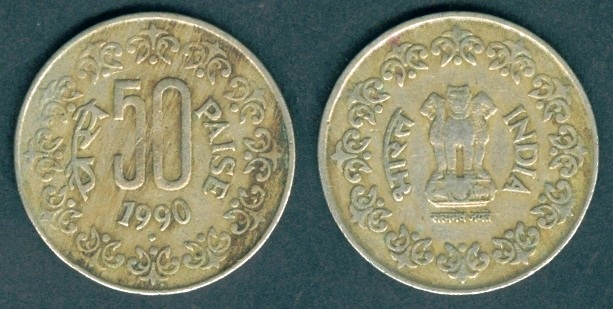 |
Same as above coin KM#65, 50 paise, but...
Year: 1990.
Weight: 5.01 g
[5.00g].
Mint:
Bombay (Diamond mintmark below Date). Mintage:
N/A. |
|
 |
Same as above KM#69 50 paise,
but...
Year: 1990.
Weight: 3.78 g
[3.80g]. Mint:
Noida (Dot mintmark below Date). Mintage:
N/A. Small Dot Type. |
|
 |
Same as above coin but having Large dot as mint
mark.
Weight: 3.75 g
[3.80g]. |
|
 |
KM#85 Rupee.
Year: 1990.
Weight: 6.05 g
[6.00g].
Metal: Copper-Nickel.
Diameter: 25.50 mm.
Thickness:
1.47 mm. Edge:
Reeded. Alignment:
Medal. Mint:
Bombay (Diamond mintmark at the bottom on
Obverse side). Note: Bombay
mint has also a MULE coin produced without Dotted circle near the
rim on the Reverse side (Value side). |
|
Obverse: Dr.
Bhimrao Ramji Ambedkar portrait facing 3/4 right in the center. "डा.बी.आर.अम्बेडकर"
(Dr. B.R. Ambedkar) written on the top left side clockwise.
"DR. B.R. AMBEDKAR" written on the top right side clockwise. "जन्म
शती"
(janm shatee) [Birth Centenary] written at the bottom left side anti-clockwise.
"CENTENARY" written at the bottom right side anti-clockwise. Date
"1990" written at the bottom with mintmark below it.
Dotted circular border near the edge.
Reverse:
Ashoka Pillar Lion Capitol in the center
position with
"सत्यमेव
जयते" (Satyameva Jayate) [Truth alone triumphs]
written below it. "भारत"
(bharat) written on the top left side clockwise and "INDIA" written
on the top right side clockwise. "रुपया"
(rupaya) written at the bottom left side anti-clockwise and "RUPEE"
written at the bottom right side anti-clockwise. Numeral "1"
written at the bottom. Dotted circular border near the edge. Mintage:
N/A.
Mintage Years:
1990B and 1990Hy.
Subject: Birth
Centenary of Dr. Bhimrao Ramji Ambedkar 1891-1991.
Bhimrao Ramji Ambedkar (14 April 1891 06 December 1956), also
known as Babasaheb Ambedkar, was an Indian jurist, economist,
politician and social reformer who inspired the Dalit Buddhist
movement and campaigned against social discrimination towards the
untouchables (Dalits). He was independent India's first law and
justice minister, the major architect of the Constitution of India.
His teacher, Krishna Keshav Ambedkar, changed his surname from 'Ambadawekar'
to his own surname 'Ambedkar' in school records. In 1906, when he
was about 15 years old, his marriage to a nine-year-old girl,
Ramabai (b. 07 February 1898 - d. 27 May 1935), was arranged.
Ramabai died at the age of 37 at Rajgruha in Hindu Colony, Dadar,
Bombay, after a prolonged illness. She had been married to Ambedkar
for 29 years. The couple had five children Yashwant, Gangadhar,
Ramesh, Indu (daughter) and Rajratna. Apart from Yashwant
(19121977), the other four died in their childhood.
In 1932, British announced the formation of a separate electorate
for "Depressed Classes" in the Communal Award. Gandhi fiercely
opposed a separate electorate for untouchables, saying he feared
that such an arrangement would divide the Hindu community. Gandhi
protested by fasting while imprisoned in the Yerwada Central Jail of
Poona. Following the fast, Congress politicians and activists such
as Madan Mohan Malaviya and Palwankar Baloo organised joint meetings
with Ambedkar and his supporters at Yerwada. On 25 September 1932,
the agreement known as Poona Pact was signed between Ambedkar (on
behalf of the depressed classes among Hindus) and Madan Mohan
Malaviya (on behalf of the other Hindus). The agreement gave
reserved seats for the depressed classes in the Provisional
legislatures, within the general electorate. Due to the pact, the
depressed class received 148 seats in the legislature, instead of
the 71 as allocated in the Communal Award earlier proposed by
British Prime Minister Ramsay MacDonald.
After the Lahore resolution (1940) of the Muslim League demanding
Pakistan, Ambedkar wrote a 400 page tract titled Thoughts on
Pakistan, which analysed the concept of "Pakistan" in all its
aspects. Ambedkar argued that the Hindus should concede Pakistan to
the Muslims. He proposed that the provincial boundaries of Punjab
and Bengal should be redrawn to separate the Muslim and non-Muslim
majority parts. He thought the Muslims could have no objection to
redrawing provincial boundaries. If they did, they did not quite
"understand the nature of their own demand". Scholar Venkat
Dhulipala states that Thoughts on Pakistan "rocked Indian politics
for a decade". It determined the course of dialogue between the
Muslim League and the Indian Naitonal Congress, paving the way for
the Partition of India.
Ambedkar served as 1st Minister of Law and Justice: 15 August 1947
September 1951, Chairman of the Constitution Drafting Committee: 29
August 1947 24 January 1950 and Labour Member - Viceroy's
Executive Council: 1942 1946. Ambedkar, the Chairman of the
Drafting Committee, presenting the final draft of the Indian
Constitution to President Rajendra Prasad on 25 November 1949. The
Constitution was adopted on 26 November 1949 by the Constituent
Assembly.
Ambedkar was a prolific student, earning doctorates in economics
from both Columbia University and the London School of Economics,
and gained a reputation as a scholar for his research in law,
economics and political science. In his early career he was an
economist, professor, and lawyer. His later life was marked by his
political activities; he became involved in campaigning and
negotiations for India's independence, publishing journals,
advocating political rights and social freedom for Dalits, and
contributing significantly to the establishment of the state of
India. He converted to Buddhism in 1956, initiating mass conversions
of Dalits.
Ambedkar contested in the Bombay North first Indian General Election
of 1952, but lost to his former assistant and Congress Party
candidate Narayan Kajrolkar. Ambedkar became a member of Rajya Sabha,
probably an appointed member. He tried to enter Lok Sabha again in
the by-election of 1954 from Bhandara, but he placed third (the
Congress Party won). By the time of the second general election in
1957, Ambedkar had died.
Ambedkar also criticised Islamic practice in South Asia. While
justifying the Partition of India, he condemned child marriage and
the mistreatment of women in Muslim society.
In 1990, the Bharat Ratna, India's highest civilian award, was
posthumously conferred upon Ambedkar. Ambedkar's legacy includes
numerous memorials and depictions in popular culture. |
|
 |
Same as above KM#85 Rupee,
but...
Year: 1990.
Weight: 6.24 g
[6.00g]. Mint:
Hyderabad (Star mintmark below Date). Mintage:
N/A. |
|
_Bombay-15thAnniversaryICDS.jpg) |
KM#86 Rupee.
Year: ND (1990).
Weight: 5.99 g
[6.00g].
Metal: Copper-Nickel.
Diameter: 25.50 mm.
Thickness:
1.47 mm. Edge:
Reeded. Alignment:
Medal. Mint:
Bombay (Diamond mintmark at the bottom on
Obverse side). |
|
Obverse: "वसुधैव
कुटुम्बकम" (vasudhaiv kutumbakam) [The whole world is a family] written
at the top.
Abstract Mother carrying child in the center; surrounded by rays.
Mintmark below at the bottom ray. "समेकित बाल विकास सेवा योजना
के 15 वर्ष" (samekit baal vikaas seva yojana ke 15 varsh) [15 years
of Integrated Child Development Services Scheme] written at the left
side clockwise. "15 YEARS OF I.C.D.S." written at the right side
clockwise. "1975-1990" written at the bottom right side
anti-clockwise.
Reverse:
Ashoka Pillar Lion Capitol in the center
position with
"सत्यमेव
जयते" (Satyameva Jayate) [Truth alone triumphs]
written below it. "भारत"
(bharat) written on the top left side clockwise and "INDIA" written
on the top right side clockwise. "रुपया"
(rupaya) written at the bottom left side anti-clockwise and "RUPEE"
written at the bottom right side anti-clockwise. Numeral "1" written
at the bottom. Mintage:
N/A.
Mintage Years:
1990B and 1990Hy.
Subject: 15th
Anniversary of I.C.D.S. 1975-1990. Integrated Child
Development Services (ICDS) is a government program in India
which provides food, preschool education, primary healthcare,
immunization, health check-up and referral services to children
under 6 years of age and their mothers. The scheme was launched on
02 October 1975, discontinued in 1978 by the government of Morarji
Desai, and then re-launched by the Tenth Five Year Plan.
Tenth five year plan also linked ICDS to Anganwadi centres
established mainly in rural areas and staffed with frontline
workers. In addition to fighting malnutrition and ill health, the
program is also intended to combat gender inequality by providing
girls the same resources as boys.
A 2005 study found that the ICDS program was not particularly
effective in reducing malnutrition, largely because of
implementation problems and because the poorest states had received
the least coverage and funding. During the 20182019 fiscal year,
the Indian central government allocated ₹16,335 crores to the
program. The widespread network of ICDS has an important role in
combating malnutrition especially for children of weaker groups. |
|
 |
KM#87.1 Rupee.
Year: 1990.
Weight: 5.93 g
[6.00g].
Metal: Copper-Nickel.
Diameter: 25.50 mm.
Thickness:
1.47 mm. Edge:
Security. Alignment:
Medal. Mint:
Bombay (Diamond mintmark below the Date).
KM#87.1 type has Security edge. |
|
Obverse: "खुशहाल
बालिका भविष्य देश का" (khushahaal baalika bhavishy desh ka)
[Happy girl future of the country] written at left side. "CARE FOR
THE GIRL CHILD" written at right side. Abstract Girl below sun with
SAARC symbol to her lower left side in the center with "SAARC YEAR"
written below them. Date "1990" with mintmark at the bottom.
Heptagonal form near the border.
Reverse:
Ashoka Pillar Lion Capitol in the top center
position with
"सत्यमेव
जयते" (Satyameva Jayate) [Truth alone triumphs]
written below it. "भारत"
(bharat) written on the top left side clockwise and "INDIA" written
on the top right side clockwise. "रुपया"
(rupaya) written at the bottom left side anti-clockwise and "RUPEE"
written at the bottom right side anti-clockwise. Numeral "1" written
at the bottom. Heptagonal form near the border. Mintage:
N/A.
Mintage Years:
1990B.
Subject: 15th
Anniversary of I.C.D.S. 1975-1990. |
|
 |
KM#87.2 has Reeded edge variety, produced by 1990B
and 1990Hy. Rupee.
Year: 1990.
Weight: 6.01 g
[6.00g].
Metal: Copper-Nickel.
Diameter: 25.50 mm.
Thickness:
1.47 mm. Edge:
Reeded. Alignment:
Medal. Mint:
Bombay (Diamond mintmark below the Date). Mintage:
N/A. This coin is slightly rotated as
shown on Obverse side. |
|
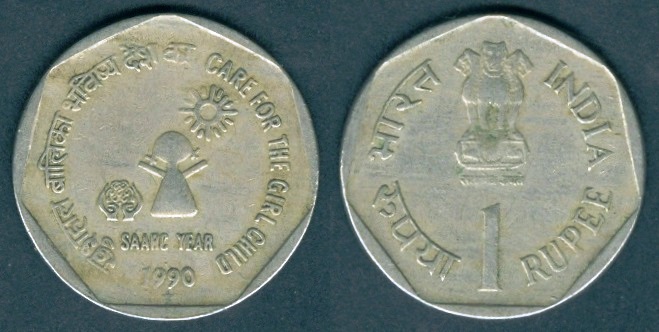 |
Same as above KM#87.2 Rupee,
but...
Year: 1990.
Weight: 6.05 g
[6.00g]. Mint:
Hyderabad (Star mintmark below Date). Mintage:
N/A. |
|
 |
KM#88.1 Rupee.
Year: 1990.
Weight: 5.99 g
[6.00g].
Metal: Copper-Nickel.
Diameter: 25.50 mm.
Thickness:
1.47 mm. Edge:
Reeded. Alignment:
Medal. Mint:
Hyderabad (Star mintmark below the Full Date).
KM#88.1 type has Reeded edge. KM#88.2 type with Plain (Smooth) edge
which was produced only by Hyderabad mint. |
|
Obverse:
Man and woman framer in the front while crops
and framing tools in the background in the center. "भविष्य के
लिए भोजन"
(bhavishy ke lie bhojan) [Food for the future] written on the top left side clockwise.
"FOOD FOR THE FUTURE" written on the top right side clockwise. "विश्व
खाद्य दिवस"
(vishv khaady divas) [World Food Day] written below the farmers
followed by Date "16 अक्टूबर 1990" (16 aktoobar 1990) and then
mintmark below them. "WORLD FOOD DAY 16 OCTOBER 1990" written at the
bottom section. Tooth border near the edge.
Reverse:
Ashoka Pillar Lion Capitol in the center
position with
"सत्यमेव
जयते" (Satyameva Jayate) [Truth alone triumphs]
written below it. "भारत"
(bharat) written on the top left side clockwise and "INDIA" written
on the top right side clockwise. "रुपया"
(rupaya) written at the bottom left side anti-clockwise and "RUPEE"
written at the bottom right side anti-clockwise. Numeral "1"
written at the bottom. Tooth border near the edge. Mintage:
N/A.
Mintage Years:
1990B and 1990Hy.
Subject: FAO -
World Food Day. |
| |
|
| |
|
|
| |
| 1991 |
| |
|
|
|
|
 |
Same as above KM#44
20 paise,
but...
Year: 1991.
Weight: 2.25 g
[2.20g].
Mint:
Calcutta (No mintmark below Date). Mintage:
N/A. |
|
 |
Same as above KM#44
20 paise,
but...
Year: 1991.
Weight: 2.15 g
[2.20g].
Mint:
Hyderabad (Star mintmark below Date). Mintage:
N/A. |
|
 |
Same as above KM#54
25 paise,
but...
Year: 1991.
Weight: 2.85 g
[2.83g].
Mint:
Bombay (Diamond mintmark below Date). Mintage:
N/A. |
|
 |
Same as above KM#54
25 paise,
but...
Year: 1991.
Weight: 2.84 g
[2.83g].
Mint:
Calcutta (No mintmark below Date). Mintage:
N/A. |
|
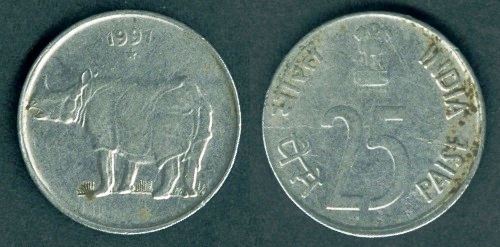 |
Same as above KM#54
25 paise,
but...
Year: 1991.
Weight: 2.90 g
[2.83g].
Mint:
Hyderabad (Star mintmark below Date). Mintage:
N/A. |
|
 |
Same as above KM#54
25 paise,
but...
Year: 1991.
Weight: 2.84 g
[2.83g].
Mint:
Noida (Dot mintmark below Date). Mintage:
N/A. |
|
 |
Same as above KM#69 50 paise,
but...
Year: 1991.
Weight: 3.80 g
[3.80g]. Mint:
Bombay (Diamond mintmark below Date). Mintage:
N/A. |
|
 |
Same as above KM#69 50 paise,
but...
Year: 1991.
Weight: 3.74 g
[3.80g]. Mint:
Calcutta (No mintmark below Date). Mintage:
N/A. |
|
 |
Same as above KM#69 50 paise,
but...
Year: 1991.
Weight: 3.80 g
[3.80g]. Mint:
Noida (Dot mintmark below Date). Mintage:
N/A. |
|
 |
KM#79.4 Rupee.
Year: 1991.
Weight: 6.16 g
[6.00g].
Metal: Copper-Nickel.
Diameter: 26.00 mm.
Thickness:
1.47 mm. Edge:
Reeded / Plain. Alignment:
Medal. Mint:
Calcutta (No mintmark below Date). Obverse: "रुपया"
(rupaya) written at the top. Numeral "1" in the center with grain ears
flank on each side. "RUPEE" written below numeral "1". Date written
at the bottom. Dots in heptagonal form near the border.
Note: This coin has Smooth / Plain
edge.
|
|
Obverse Type4: Same as
KM#79.1 but with Reeded / Milled edge but for Calcutta mint Smooth /
Plain edge.
Reverse:
Ashoka Pillar Lion Capitol in the center with
"सत्यमेव
जयते" (Satyameva Jayate) [Truth alone triumphs]
written below it. "भारत"
(bharat) written on the left side clockwise and "INDIA" written on
the right side clockwise. Dots in heptagonal form near the border.
Mintage:
N/A.
Mintage Years:
1988 (C), 1989 (B), 1989 (C), 1989 (Hy), 1990
(C), 1990 (Hy) and 1991 (C).
Note:
Traces of security edge and/or mostly smooth edges are
encountered, especially for 1989. 1989-1991(C) is a variety with
bulging eyes on side lions and irregular straight hair on central
lion. |
|
 |
KM#79.5 Rupee.
Year: 1991.
Weight: 6.18 g
[6.00g].
Metal: Copper-Nickel.
Diameter: 26.00 mm.
Thickness:
1.47 mm. Edge:
Reeded. Alignment:
Medal. Mint:
Bombay (Diamond mintmark below Date). Obverse:
"रुपया"
(rupaya) written at the top. Numeral "1" in the center with grain ears
flank on each side. "RUPEE" written below numeral "1". Date written
at the bottom. Dots in heptagonal form near the border. Obverse Type5: Same as
KM#79.3 with Lions' chest hairs restyled but with Reeded / Milled
edge. |
|
Reverse:
Ashoka Pillar Lion Capitol in the center with
"सत्यमेव
जयते" (Satyameva Jayate) [Truth alone triumphs]
written below it. "भारत"
(bharat) written on the left side clockwise and "INDIA" written on
the right side clockwise. Dots in heptagonal form near the border. Mintage:
N/A.
Mintage Years:
1990 (B), 1990 (C), 1991 (B) and 1991 (Hy). |
|
 |
Same as above KM#79.5 Rupee,
but...
Year: 1991.
Weight: 5.80 g
[6.00g]. Mint:
Hyderabad (Star mintmark below Date). Mintage:
N/A.
My coin has traces of smooth edge as well. |
|
_Bombay-RajivGandhiDeath.jpg) |
KM#89 Rupee.
Year: ND (1991).
Weight: 5.85 g
[6.00g].
Metal: Copper-Nickel.
Diameter: 25.50 mm.
Thickness:
1.47 mm. Edge:
Reeded. Alignment:
Medal. Mint:
Bombay (Diamond mintmark left of Date 1991). |
|
Obverse:
Portrait of Rajiv Gandhi facing 3/4 left in
the center. "राजीव गांधी"
(raajeev gaandhee) written on the left side clockwise.
"RAJIV GANDHI" written on the right side clockwise. Dates "1944
: 1991" written at the bottom section with mintmark before "1991".
Gap in tooth, border near the edge.
Reverse:
Ashoka Pillar Lion Capitol in the center
position with
"सत्यमेव
जयते" (Satyameva Jayate) [Truth alone triumphs]
written below it. "भारत"
(bharat) written on the top left side clockwise and "INDIA" written
on the top right side clockwise. "रुपया"
(rupaya) written at the bottom left side anti-clockwise and "RUPEE"
written at the bottom right side anti-clockwise. Numeral "1"
written at the bottom. Gap in tooth, border near the edge. Mintage:
N/A.
Mintage Years:
ND (1991B) and ND (1991Hy).
Subject: Death /
Assassination of Rajiv Gandhi in 1991. Rajiv Ratna
Gandhi (b. 20 August 1944 d. 21 May 1991) was an Indian
politician who served as the 6th Prime Minister of India from 31
October 1984 to 02 December 1989. He took office after the 31
October 1984 assassination of his mother, Prime Minister Indira
Gandhi, to become the youngest Indian Prime Minister at the age of
40. He served as Leader of the Opposition: 18 December 1989 23
December 1990, President of the Indian National Congress: 19851991
and Member of Parliament
for Amethi: 17 August 1981 21 May 1991.
Gandhi was a scion of the politically powerful Nehru-Gandhi family,
which had been associated with the Indian National Congress party.
For much of his childhood, his maternal grandfather Jawaharlal Nehru
was Prime Minister. Gandhi attended college in the United Kingdom.
He returned to India in 1966 and became a professional pilot for the
state-owned Indian Airlines. In 1968, he married Sonia Gandhi; the
couple settled in Delhi to a domestic life with their children Rahul
Gandhi and Priyanka Gandhi Vadra. For much of the 1970s, his mother
Indira Gandhi was prime minister and his brother Sanjay Gandhi an
MP; despite this, Rajiv Gandhi remained apolitical. After Sanjay's
death in a fighter plane crash in 1980, Gandhi reluctantly entered
politics at the behest of Indira. The following year he won his
brother's Parliamentary seat of Amethi and became a member of the
Lok Sabha - the lower house of India's Parliament. As part of his
political grooming, Rajiv was made general secretary of the Congress
party and given significant responsibility in organising the 1982
Asian Games.
In 1985, the Supreme Court of India ruled in favour of Muslim
divorcee Shah Bano, declaring that her husband should give her
alimony. Some Indian Muslims treated it as an encroachment upon
Muslim Personal Law and protested against it. Gandhi agreed to their
demands. In 1986, the Parliament of India passed The Muslim Women
(Protection of Rights on Divorce) Act 1986, which nullified the
Supreme Court's judgment in the Shah Bano case.
In February 1987, the Pakistani President Zia-ul-Haq did a surprise
visit to Delhi, where he met Gandhi to discuss "routine military
exercises of the Indian army" on the borders of Rajasthan and
Punjab. This visit ease the tension between the two countries and
both countries agreed to host Cricket World Cup the same year.
On 30 July 1987, a day after Gandhi went to Sri Lanka and signed the
Indo-Sri Lanka Accord, an honour guard named Wijemuni Vijitha Rohana
de Silva hit him on his shoulder with his rifle; Gandhi's quick
reflexes saved him from injury. The guard said his intention was to
kill Gandhi because of "the damage he had caused" to Sri Lanka.
Wijemuni was imprisoned for two-and-a-half years for the assault.
Rajiv Gandhi's last public meeting was on 21 May 1991, at
Sriperumbudur, a village approximately 40 km (25 mi) from Madras
(present-day Chennai), where he was assassinated while campaigning
for the Sriperumbudur Lok Sabha Congress candidate. At 10:10 pm, a
woman later identified as Thenmozhi Rajaratnam approached Gandhi in
public and greeted him. She then bent down to touch his feet and
detonated a belt laden with 700 g (1.5 lb) of RDX explosives tucked
under her dress. The explosion killed Gandhi, Rajaratnam, and at
least 25 other people. The assassination was captured by a
21-year-old local photographer, whose camera and film were found at
the site. The cameraman, named Haribabu, died in the blast but the
camera remained intact. Gandhi's mutilated body was airlifted to the
All India Institute of Medical Sciences in New Delhi for
post-mortem, reconstruction and embalming.
A state funeral was held for Gandhi on 24 May 1991; it was telecast
live and was attended by dignitaries from over 60 countries. He was
cremated at Veer Bhumi - Delhi, on the banks of the river Yamuna
near the shrines of his mother Indira Gandhi, brother Sanjay Gandhi,
and grandfather Jawaharlal Nehru. |
|
 |
KM#90 Rupee.
Year: 1991.
Weight: 6.09 g
[6.00g].
Metal: Copper-Nickel.
Diameter: 25.50 mm.
Thickness:
1.47 mm. Edge:
Reeded. Alignment:
Medal. Mint:
Bombay (Diamond mintmark below Date). |
|
Obverse:
Parliament building in the center with Date and mintmark above it. "राष्ट्रमंडल
संसदीय सम्मेलन"
(raashtramandal sansadeey sammelan) [Commonwealth Parliamentary
Conference] written in Hindi on the left side clockwise.
"COMMONWEALTH PARLIAMENTARY CONFERENCE" written from 11
o'clock towards right side clockwise. Decorated border near the edge.
Reverse:
Ashoka Pillar Lion Capitol in the center
position with
"सत्यमेव
जयते" (Satyameva Jayate) [Truth alone triumphs]
written below it. "भारत"
(bharat) written on the top left side clockwise and "INDIA" written
on the top right side clockwise. "रुपया"
(rupaya) written at the bottom left side anti-clockwise and "RUPEE"
written at the bottom right side anti-clockwise. Numeral "1"
written at the bottom. Decorated border near the edge. Mintage:
N/A.
Mintage Years:
1990B and 1990 (Bombay Proof with "B"
mintmark).
Subject:
Commonwealth Parliamentary Conference 1991. The
Commonwealth Parliamentary Association (CPA), previously known
as the Empire Parliamentary Association (founded in 1911), is an
organisation which works to support good governance, democracy and
human rights.
As of 1989, the CPA acknowledges as Patron the Head of the
Commonwealth, Her Majesty Queen Elizabeth II and as Vice-Patron,
by rotation Heads of State or Heads of Government of the
Commonwealth national government hosting its upcoming annual
Commonwealth Parliamentary Conference. The Association's supreme
authority is the General Assembly, constituted by delegates to the
annual Commonwealth Parliamentary Conference. The business and
activities of the CPA are managed by an Executive Committee, which
reports to the General Assembly. The CPA's funds are derived from
membership fees paid by its branches, as well as from two trust
funds and benefactors.
The official publication of the Commonwealth Parliamentary
Association is The Parliamentarian, the Journal of Commonwealth
Parliaments which was first published in January 1920. The
organisation administers the Commonwealth Women Parliamentarians (CWP),
a network across the Commonwealth which promotes greater
representation for women in Parliament, the CPA Small Branches
network, representing parliaments and legislatures with populations
below 500,000 people, and the Commonwealth Youth Parliament, an
annual gathering of young people hosted by a Commonwealth
Parliament.
The Commonwealth Parliamentary Association (CPA) currently has
approximately 180 branches and is divided into nine regions
Africa; Asia; Australia; British Islands and Mediterranean; Canada;
Caribbean, Americas and Atlantic; India; Pacific, and South-East
Asia. The CPA Headquarters Secretariat is
based in London. |
|
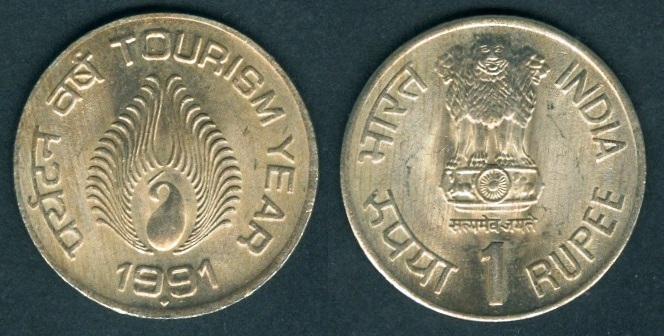 |
KM#91 Rupee.
Year: 1991.
Weight: 6.13 g
[6.00g].
Metal: Copper-Nickel.
Diameter: 25.50 mm.
Thickness:
1.47 mm. Edge:
Reeded. Alignment:
Medal. Mint:
Bombay (Diamond mintmark below Date). |
|
Obverse: Abstract
peacock in the center. "पर्यटन वर्ष"
(paryatan varsh) [Tourist year] written in Hindi on the left side clockwise.
"TOURISM YEAR" written from 11 o'clock towards right side
clockwise. Date and mintmark at the bottom.
Reverse:
Ashoka Pillar Lion Capitol in the center
position with
"सत्यमेव
जयते" (Satyameva Jayate) [Truth alone triumphs]
written below it. "भारत"
(bharat) written on the top left side clockwise and "INDIA" written
on the top right side clockwise. "रुपया"
(rupaya) written at the bottom left side anti-clockwise and "RUPEE"
written at the bottom right side anti-clockwise. Numeral "1" written
at the bottom. Mintage:
N/A.
Mintage Years:
1991B, 1991B Proof, 1991 (Bombay Proof with
"B" mintmark) and 1991Hy.
Subject: Tourism
Year 1991. |
| |
|
| |
|
|
| |
| |
|
Early
Indian coins:
British India coins:
Coins of Indian Princely States and other
colonies:
Coins of "Republic of India" sorted under below
Presidential rulers:
Others:
|
| |
|
|
| |
|
|
| Countries
/ Territories |
| |
|
Chiefa Coins | |
|





































































_Bombay-15thAnniversaryICDS.jpg)
















_Bombay-RajivGandhiDeath.jpg)

